Walking Through an Empire: Your Guide to Topkapı Palace in Istanbul
- Ian
- Jul 24
- 16 min read

Topkapı Palace (Topkapı Sarayı) served as the administrative center and main residence of Ottoman sultans from the 1460s until the completion of Dolmabahçe Palace in 1856. Construction began in 1459 under Sultan Mehmed the Conqueror's orders, six years after the conquest of Constantinople. About 30 sultans ruled from Topkapı Palace for nearly four centuries during the Ottoman Empire's 600-year reign, with the palace housing 1,000–4,000 inhabitants, including up to 300 in the harem.
The palace was originally called the "New Palace" (Yeni Saray or Saray-ı Cedîd-i Âmire) to distinguish it from the Old Palace in Beyazıt Square. It received the name Topkapı, meaning "Cannon Gate," in the 19th century. Mehmed's original layout, which consisted of four consecutive courtyards surrounded by high walls, remains intact. Each courtyard served different purposes and was separated by a gate that incrementally restricted entry, culminating in the most-private third and fourth courtyards.
I visited at 13:30 on a Friday in July and, while it was hot, there are many shaded areas you can take a respite from the sun and of course the building interiors are relatively cool. Despite being in peak season we had very little crowds to deal with and lines at security and ticketing were pretty small at maybe 5 minutes. The line did fluctuate at security quite a bit though since every now and then a LARGE tour group would clog the flow. Check the visitor tips below to find out about best times to visit and other info.
🏰 First Courtyard (Outer Courtyard) – Alay Meydanı

Entry: Imperial Gate (Bab-ı Hümayun)
The first courtyard is the largest and only public courtyard. During the reign of the Ottoman Empire, any unarmed person could enter through the Imperial Gate. The courtyard's open space made it ideal for ceremonies and processions, and it was likely the most bustling of the palace's squares. It is in this courtyard you will find the ticket office for the palace and the audio guide pick up. You need to clear security at this gate in order to access the remainder of the palace. I had my backpack with water and books and the like. They are only really looking for any weapons or other illegals items.

Fountain of Sultan Ahmed III
Located just outside the Imperial Gate, this ornate baroque fountain dates to 1729 and serves as a magnificent introduction to the palace complex.
Hagia Eirene (Aya İrini)
Hagia Eirene was originally a church during the Byzantine Empire and served as an armory where weapons could be repaired (called a cebehâne) during the Ottoman Empire, featuring a characteristically austere Byzantine brick façade. Originally a Byzantine church from the 4th century, it now serves as a museum known for its extraordinary acoustics, hosting classical concerts.
Imperial Mint (Darphane-i Âmire)
Established in 1727, the Imperial Mint highlights the empire's monetary history. This structure demonstrates the administrative functions that extended throughout the palace complex.
Executioner's Fountain
The Executioner's Fountain enriches this courtyard, symbolizing historical rituals. This fountain served a grim purpose - executioners would wash their hands and swords here after carrying out sentences.
⚖️ Second Courtyard – Divan Meydanı (Administrative Core)

Entry: Gate of Salutation (Bâb-üs Selâm/Middle Gate)
The Gate of Salutation recalls medieval European fortresses with its pointed towers and crenelated walls. Since the Gate of Salutation was the entrance to the heart of the palace, only the Sultan was allowed to enter on horseback while all others had to dismount.
The second courtyard, also called Divan Square, was the administrative centre of the palace. Only official visitors and members of the court could enter the space.
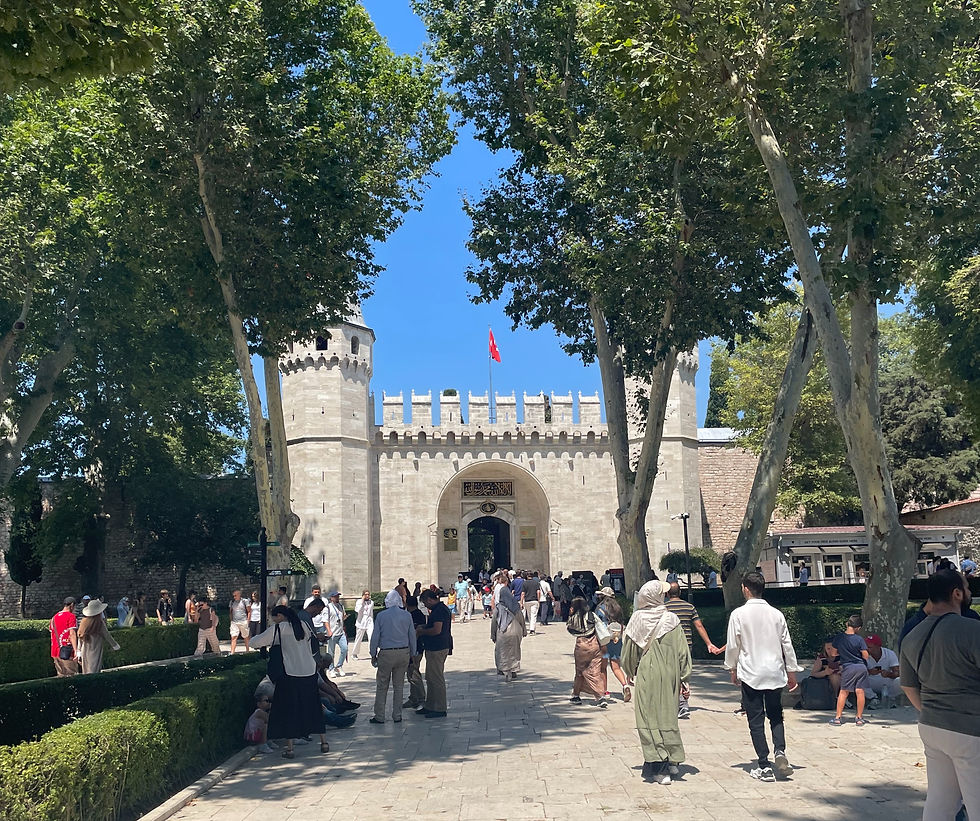

Imperial Council Chamber (Dîvân-ı Hümâyûn)
Council members met several times a week to discuss state affairs in the Domed Chamber (sometimes called Council Hall). The grand vizier (chief minister) led state meetings, and the sultan sometimes listened in through a grilled window from a small room within the adjacent Tower of Justice.
The Sultan and Queen Mother (Valide Sultan) would often attend Imperial Council meetings discretely from behind a window with a golden grill. When the Sultan would draw the curtain on the window or rap on the grill, it signaled that the meeting was over.



The chamber consists of multiple rooms:
Main Council Hall: Decorated with Kütahya tiles
Secretarial Chamber: Occupied by the secretarial staff of the viziers who would record what was discussed during meetings, bearing the tughra (monogram) of Sultan Mustafa III
Inkwell Chamber (Divit Odası): Where scribes would write letters carrying state secrets as well as official documents. Today, it serves as a small museum of clocks. This collection includes 380 mechanical clocks collection, which is divided into three parts: Ottoman clocks made by Turkish masters, European clocks including magnificent pieces by Breguet, and Swiss clocks and pocket watches from the 19th century.
The collection features some fascinating pieces including pocket watches with portraits of sultans, enameled watches from Geneva, musical cage clocks, and even curious timepieces shaped like a pistol and spectacles made by the Rochat brothers.
Tower of Justice
The Tower of Justice, the palace's tallest structure, offered the sultan a view of the entire palace and thus served as a reminder of the sultan's omnipresence not only in the court but in the daily life of the complex. The Tower of Justice includes a small room through which the Sultan could listen to the meetings of the council without being noticed through a veiled window facing the council chamber.
Palace Kitchens
The great Palace Kitchens on the right (east) incorporate a dedicated Helvahane (confectionery kitchen). They hold a small portion of Topkapı's vast collection of Chinese celadon porcelain, valued by the sultans for its beauty but also because it was reputed to change colour if touched by poisoned food.
At its peak, more than 4,000 people lived and worked in Topkapı Palace — it was like a little city-state, complete with its own rules, roles, and routines! The massive kitchen complex served this enormous population.
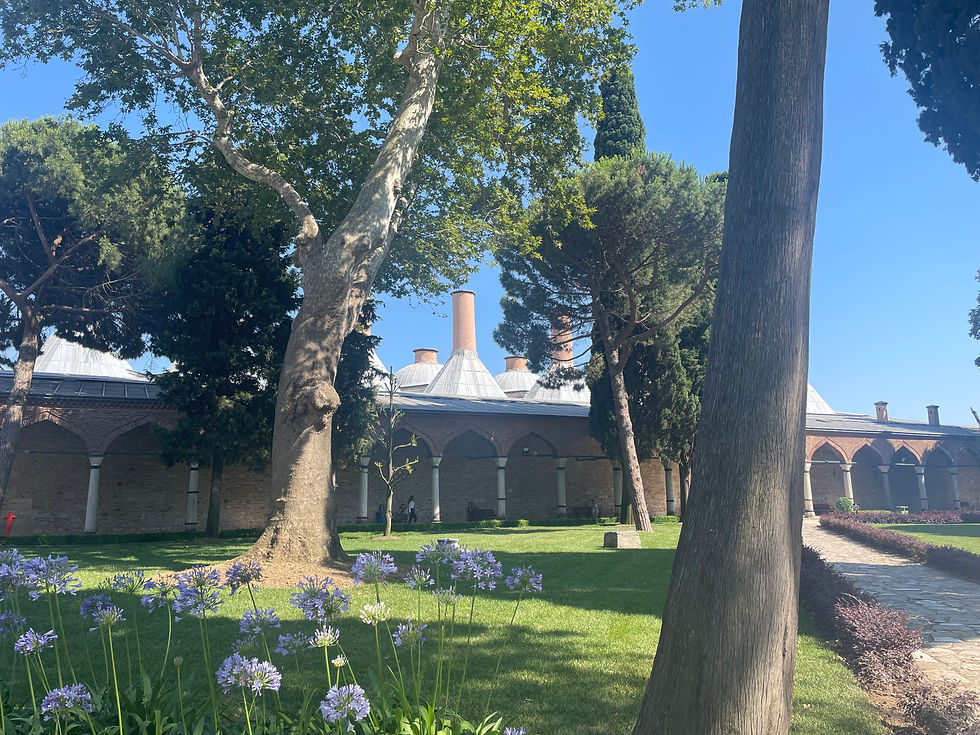
Outer Treasury (Arms and Armor Collection)
The building where the arms and armor are exhibited was originally a treasury of the palace. As the Third Courtyard had an inner treasury, the one out here was also known as the Outer Treasury. The treasury financed the administration of the state.
Topkapı Palace has one of the world's greatest collections of Islamic arms. With a collection that spans 1300 years, you can see arms and weapons that date back to the 7th century. Most of the collection comprises Ottoman weapons, but it also includes swords and armor from the Umayyad and Abbasid dynasties. There were a few swords (seen in gallery below) that were absolutely massive and I don't know how anyone could wield those beasts.
🔒 The Imperial Harem – Secrets and Shadows
The harem wing was added at the end of the 16th century and contained more than 400 rooms. Many of the rooms and features in the Harem were designed by Mimar Sinan. At its peak, the Harem included more than 300 rooms, 9 baths, 2 mosques, a hospital, laundry room, and countless hidden passageways.
Carriage Gate (Araba Kapısı)
An inscription above one of the entrances to the harem, the Araba (Carriages) Gate, opens onto the second courtyard next to the Kubbealtı; it bears the date AH 995 / AD 1588.

Quarters of the Black Eunuchs
The powerful black eunuchs, led by the Chief Black Eunuch (Kızlar Ağası), controlled access to the Harem and wielded significant political influence.
Courtyard of the Queen Mother
The heart of Harem power, where the Valide Sultan (Queen Mother) resided. The Queen Mother came to the Harem with pomp and circumstance and assumed the title of Valide Sultan. She ran the Harem and ruled over the members of the dynasty. The Valide Sultan who influenced the political life of the Ottoman Empire during various periods of history had the authority to regulate the relations between the Sultan and his wives and children.
Apartments of the Queen Mother
The walls revetted with the quality products of the 17th century Ottoman tile industry are decorated with panoramic views where in the 19th century western influence is felt. On the lower stories of the apartments are the quarters of the concubines while the upper story rooms are those of the Queen Mother and her Kalfas.
Sultan's Private Chambers
The apartments of the Queen Mother are connected by a passage, leading into the Queen Mother's bathroom, to the quarters of the Sultan.
Privy Chamber of Murat III
The Privy Chamber of Murat III is the oldest and finest surviving room in the harem, having retained its original interior. It was a design of the master architect Sinan and dates from the 16th century. Its dome is only slightly smaller than that of the Throne Room. The room is decorated with blue-and-white and coral-red İznik tiles. The rich floral designs are framed in thick orange borders of the 1570s. A band of inscriptional tiles runs around the room above the shelf and door level. The large fireplace with gilded hood (ocak) stands opposite a two-tiered fountain (çeşme), skilfully decorated in coloured marble. The flow of water was meant to prevent any eavesdropping, while providing a relaxed atmosphere to the room. The two gilded baldachin beds date from the 18th century.

Twin Kiosk/Crown Prince Apartments (Kafes)
The Twin Kiosk / Apartments of the Crown Prince (Çifte Kasırlar / Veliahd Dairesi) consists of two privy chambers built in the 17th century, at different times. The crown prince (Şehzadeler) lived here in seclusion; therefore, the apartments were also called kafes (cage).
Also called Kafes, this was a secluded area within the Imperial Harem where the sultan's potential successors were kept to prevent power struggles. The Gilded Cage was a gilded prison where princes lived in isolation, waiting for their fate.
🌿 Third Courtyard – Enderûn Avlusu (Private Imperial Domain)
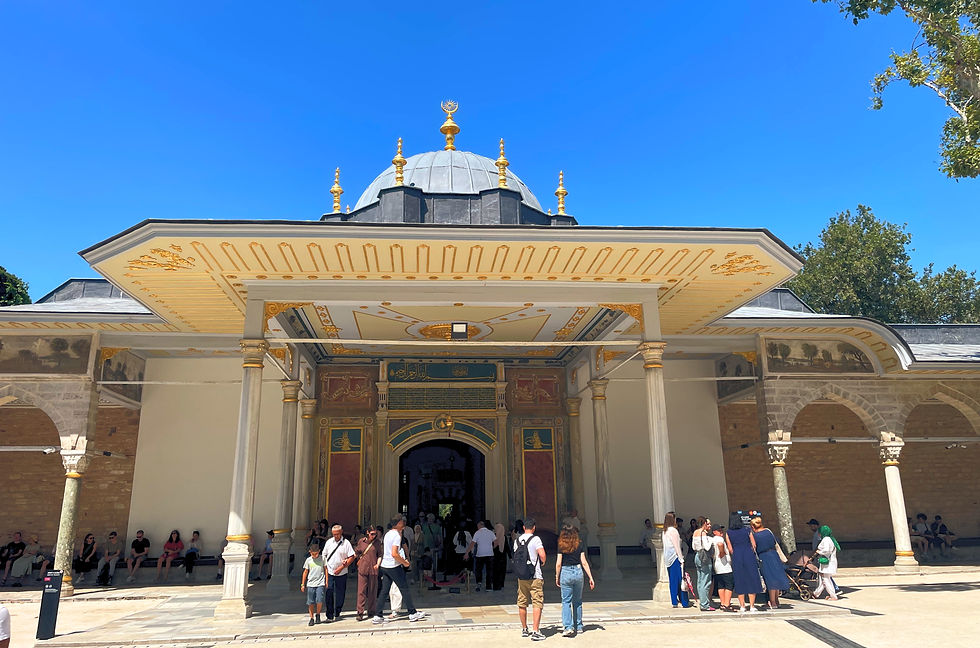
Entry: Gate of Felicity (Bâbüssaâde)
This gate marks the entrance to the Inner Court, with its dome supported by lean marble pillars, signifying the Sultan's presence. Entry was strictly controlled, and only permitted with the Sultan's consent or under specific conditions for the Grand Vizier.
Audience Chamber/Chamber of Petitions (Arz Odası)
Right behind the Gate of Felicity is the Audience Chamber, also called the Chamber of Petitions. This 15th-century building is decked with beautiful blue, turquoise, and white tiles and decorated with precious carpets and pillows. The main throne room is inside the audience chamber. The slightly elevated throne is covered with gold cloth and has a baldachin decked with several pieces of brocade with pearls and emerald and ruby plaques sewn in.

Library of Ahmed III
Among the important buildings in this, the third courtyard are the library of Ahmed III. The palace libraries, particularly the Library of Ahmed III, housed countless manuscripts and works of literature, creating a rich intellectual environment.
Sacred Safekeeping Rooms (Chamber of Sacred Relics)
These rooms, sumptuously decorated with İznik tiles, house many relics of the Prophet. When the sultans lived here, the rooms were opened only once a year, for the imperial family to pay homage to the memory of the Prophet on the 15th day of the holy month of Ramazan.
The Sacred Relics rooms contain several chambers:
Destimal Chamber
The Destimal Chamber is the room in which Abraham's Pot, Joseph's Turban, the Staff of Moses, David's Sword, scrolls belonging to John the Baptist, and Muhammad's footprint are on display.
Şadırvanlı Sofa
The Şadırvanlı Sofa is the room where the keys to the Kaaba, gutters of the Kaaba, the casing of the Black Stone (Hacerü'l-Esved), the Door of Repentance, and the swords of Muhammad's companions are on display.
Audience Chamber (Sacred Relics)
The Audience Chamber, also known as the House of Petitions (Arzhane) houses a piece from a tooth of Muhammad (Dendan-ı Saadet), hair from the beard of Muhammad (Sakal-ı Şerif), the Seal of Muhammad (Mühr-ı Saadet), an autographed Letter of Muhammad (Name-ı Saadet), and Muhammad's cloak.
The Sacred Relics Chamber is the only place in the entire Topkapı Palace where photos aren't allowed. The Quran is recited continuously in this room.
Holy Banner Chamber
The second most important relic is the Holy Banner, also known as the Sacred Standard of Muhammad (Sancak-ı Şerif, literally the "Noble Banner"). The banner was first used in a battle against the Austrian Habsburgs in 1593 and again for a war in Hungary in 1594. After Mehmed III took the banner and won the Siege of Eger in 1596, the banner became a victory symbol for the Ottoman forces.
Dormitory of the Privy Chamber
Next to the sacred Safekeeping Rooms is the Dormitory of the Privy Chamber, which houses an exhibit of portraits of 36 sultans. The highlight is a wonderful painting of the Enthronement Ceremony of Sultan Selim III (1789) by Konstantin Kapidagli.

Imperial Treasury (Conqueror's Pavilion)
Located on the eastern edge of the Third Court, Topkapı's Treasury features an incredible collection of objects made from or decorated with gold, silver, rubies, emeralds, jade, pearls and diamonds.
The Conqueror's Pavilion was built between 1462 and 1463 by Mehmed the Conqueror. It's one of the oldest surviving buildings in the palace. The pavilion features four chambers accessible via a colonnaded portico facing the courtyard. Mehmed the Conqueror used the pavilion as his private apartments. It was later converted to the Imperial Treasury to hold valuable objects belonging to the Ottoman dynasty. The Treasury consists of four magnificent rooms:
Room 1: Ceremonial Objects and Weapons
Around the room, in wall-mounted showcases, are a magnificent suit of armor belonging to Sultan Mustafa III, decorated with precious stones and gold-plated steel mesh. Alongside it is a sword, battle shield, and two gold-plated silver stirrups, all adorned with precious stones. There are also pearl-decorated Koran bindings that once belonged to the royal family, and Sultan Murat IV's throne made of ebony inlaid with mother-of-pearl and ivory.
Room 2: Jade and Crystal Objects
In the glass showcases, you'll find jade and rock-crystal objects, many of which were crafted in the palace workshops. A particularly captivating piece is a jade vessel in the shape of a ship, decorated with precious stones, a gift from Russian Tsar Nikolai II. Below these rock-crystal items are beautiful writing boxes and ink containers with gold covers, embellished with diamonds and emeralds.
Room 3: Crown Jewels and Famous Treasures
Houses the palace's most famous treasures:
Topkapı Dagger: The famous Topkapı Dagger (seen in the title image), object of the criminal heist in Jules Dassin's 1964 film Topkapı. This features three enormous emeralds on the hilt and a watch set into the pommel.
Spoonmaker's Diamond: The Kasıkçı (Spoonmaker's) Diamond, a teardrop-shaped 86-carat rock surrounded by dozens of smaller stones that was first worn by Mehmet IV at his accession to the throne in 1648.
Throne of Ahmed I: The extraordinary Throne of Ahmed I (aka Arife Throne), which is inlaid with mother-of-pearl and was designed by Sedefhar Mehmet Ağa, architect of the Blue Mosque.
Room 4: Imperial Regalia and Personal Items
Contains additional imperial treasures, ceremonial objects, and personal belongings of the sultans.
Dormitory of the Treasury Ward
The Dormitory of the Treasury sits on the north end of the 3rd Courtyard. It was built during the reign of Mehmed the Conqueror and was restored by Abdülmecid I after it was damaged by fire in 1856. It was managed by the Treasury Ward and housed staff responsible for guarding the Imperial Treasury. The building underwent a 9-year restoration and reopened to the public on April 20, 2023. The Dormitory of the Treasury houses a collection of calligraphy. Some of the finest examples of Ottoman calligraphy and sultan's tughras are on display.
🌸 Fourth Courtyard – Private Gardens and Kiosks
Pleasure pavilions occupy the palace's Fourth Court. This final section of the palace was the most secluded and peaceful part of Topkapı , designed as a place for the sultan to relax and entertain in privacy. In a sense, this was the "backyard" of Topkapı Palace.
Tulip Garden (Hasbahçe)
The hasbahçe behind the third courtyard, which belonged to the sultan, was built on several levels. Due to the fact that this area was used for growing tulips, it is also known as the Tulip Garden.

Marble Terrace
Up the stairs at the end of the Tulip Garden is the Marble Terrace, a platform with a decorative pool, three pavilions.

Revan Pavilion
Murat IV built the Revan Kiosk in 1636 after reclaiming the city of Yerevan (now in Armenia) from Persia. The Bağdat and Revan pavilions, built by Murad IV (1623-1640) in honour of victorious crusades, are on this marble terrace with a pool and were the sultan's private areas. These two pavilions are great examples of seventeenth-century Ottoman civilian architecture.
Baghdad Pavilion
In 1639 Murat IV constructed the Baghdad Kiosk, one of the last examples of classical palace architecture, to commemorate his victory over that city. Notice its superb İznik tiles, painted ceiling and mother-of-pearl and tortoiseshell inlay.
Erected to celebrate Murad IV's Baghdad campaign in 1638, it mirrors the Yerevan Kiosk with a marble façade, porphyry strips, and interiors epitomizing Ottoman design.


Circumcision Room (Sünnet Odası)
The small Circumcision Room was used for the ritual that admits Muslim boys to manhood. Built by İbrahim I in 1640, the outer walls of the chamber are graced by particularly beautiful tile panels.
Built by Sultan Ibrahim I in 1640, this summer kiosk for circumcising young princes features blue tile decorations with floral designs, symmetric proportions, and windows with small fountains. Used for 40-day religious retreats, it has a central dome, sofa-lined apses, a fireplace, and a mix of marble and İznik tiled walls.

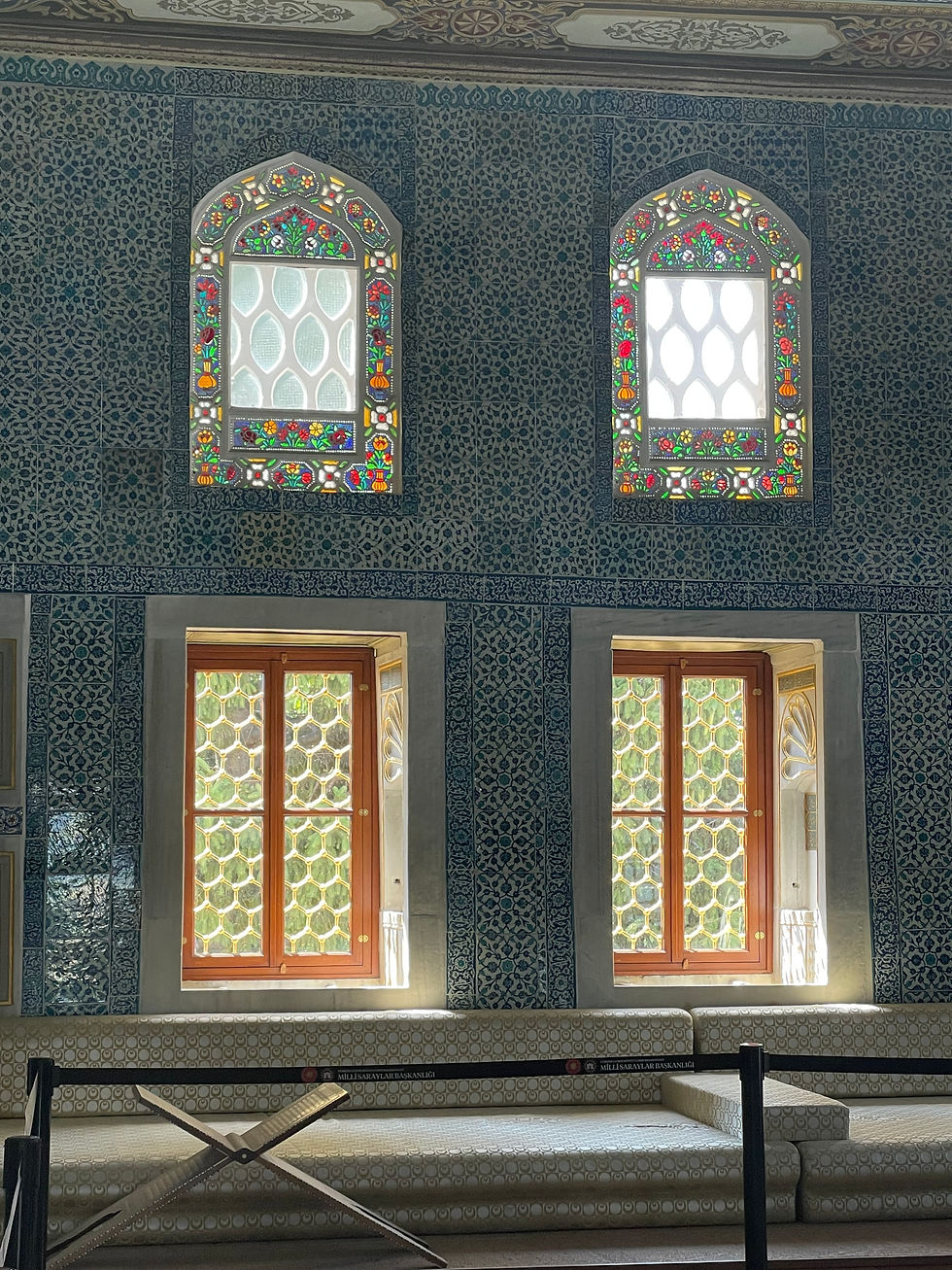
İftariye Pavilion (Iftariye Kameriyesi)
The whimsical İftariye Kameriyesi, a small structure commissioned by İbrahim I ('the Crazy') in 1640 as a picturesque place to break the fast of Ramazan.
Notable within this courtyard is the Iftariye Kameriyesi, an ornate gilt-bronze Iftar pergola where the Sultans would break their Ramadan fast.
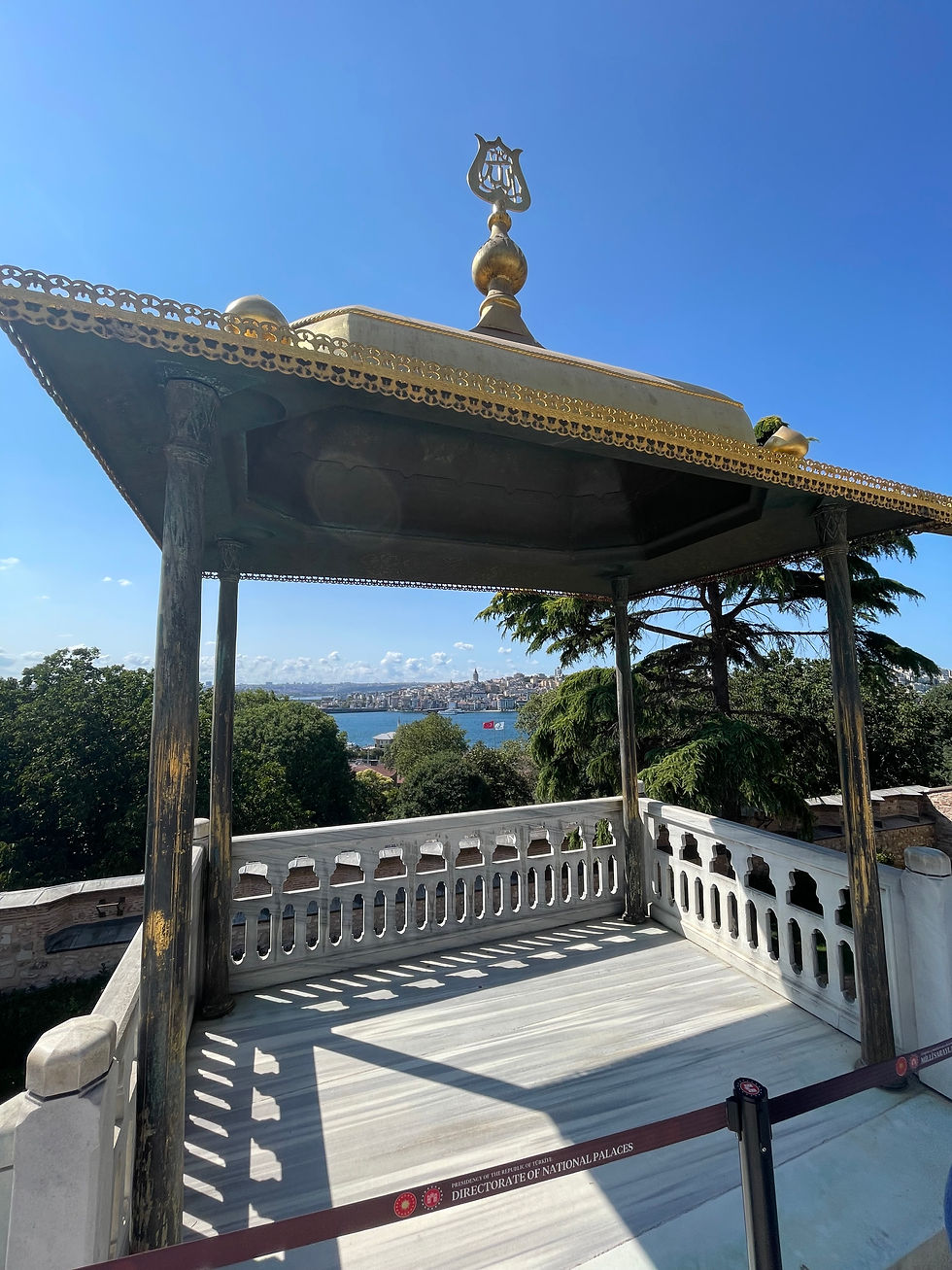
Mecidiye Pavilion
The Mecidiye Pavilion, built in the 1850s, is situated in the same corner of the garden that looks at the Marmara Sea, and is the final building of the palace. Built in a Western style, this pavilion was still used for ceremonies and visits held at Topkapı Palace even after the palace moved to Dolmabahçe.
The last building added to the Topkapı Palace was the Mecidiye Pavilion, built under Sultan Abdülmecid (AH 1255–78 / AD 1839–61).
Wardrobe Chamber (Esvap Odası)
The Wardrobe Chamber, also built in 1858, is just outside the Mecidiye Pavilion. The Sultan would dress there before visiting the Sacred Relics.
Terrace Mosque (Sofa Camii)
Finally, a few steps from the Mecidiye Pavilion is the Terrace Mosque. It was constructed in the early 19th century under Mahmud II for officials of the Treasury Ward to perform their prayers. It stood on the space once occupied by Kiosk of the Swordbearer (Silahdar Köşkü), which was demolished in 1809. The mosque was restored by Abdülmecid I in 1858.

Hekimbaşı Tower and Sofa Pavilion
The Hekimbaşı Tower and Sofa Pavilion, one of the most beautiful examples of seventeenth-century Ottoman rococo architecture dating back to 1752, can be considered to be significant buildings in the hasbahçe.
Stone Throne
The fourth courtyard is also the home of The Stone Throne. This ancient marble throne was used for outdoor ceremonies.
Outer Terrace
One of the most stunning viewpoints of Istanbul can be found in Topkapi Palace's Fourth Courtyard. Offers panoramic views of Istanbul, the Golden Horn, and the Sea of Marmara from the Fourth Courtyard's lower level terrace.

🕌Architectural and Cultural Significance
The layout and appearance of Topkapı Palace was unique amongst not only European travelers, but also Islamic or oriental palaces. European travelers described it as "irregular, asymmetric, non-axial, and [of] un-monumental proportions". Ottomans called it "The Palace of Felicity".
Unlike typical European palaces, which feature one large building with outlying gardens, Topkapı is a series of pavilions, kitchens, barracks, audience chambers, kiosks and sleeping quarters built around a central enclosure.
The palace is an extensive complex rather than a single monolithic structure, with an assortment of low buildings constructed around courtyards, interconnected with galleries and passages.
The palace complex showcases mixtures of tastes of the Ottoman, European, and Islamic architectural styles and decorations, making it a unique testament to the cultural synthesis that characterized the Ottoman Empire.
In 1924, a year after Turkey became a republic, Topkapı Palace became a museum. Today, it stands as one of the world's most significant historical sites, offering visitors an unparalleled glimpse into the grandeur, complexity, and daily life of the Ottoman imperial court.

🧭 Visitor Tips
Hours: Open daily except Tuesdays from 9:00 - 18:00 with a last admission time of 17:00.
Cost: For Turkish nationals (requires valid ID) the cost is heavily discounted at 400TL whereas foreigners can expect to pay 2400TL which equates to about $60. Tickets for the Harem run around an additional 900TL or around $22. You must buy a ticket to the palace in order to visit the Harem but you can just visit the palace and skip the Harem if you wish. Children under 6 are free and students aged 7-25 can get in for a discounted rate but you will need to have their ID with you to get this rate. We didn't have my daughter's ID and despite visibly being a child we had to pay full price. Oh well, still worth it.
Best Time to Visit: Morning or late afternoon, spring and fall offer cooler temperatures and smaller crowds. Weekdays are less crowded than weekends and Fridays tend to be the quietest day of the week as it is the Muslim day of prayer and many Turkish residents will be attending a Khutbah sermon. I would avoid planning to visit either the Hagia Sofia or the Blue Mosque (both are near Topkapı) on Fridays for that reason as well.
Allow: At least 3–4 hours for the main complex, and 1–1.5 hours for the Harem.
Audio Guide: Audio guides are free at the entry gate but require a deposit of a valid ID such as driver's license or passport. That being said, the audio guides really don't give much more information than what you can read on the placards throughout the museum. You could always opt for a guided tour as well and these generally cost around $75 - $100 per person depending on who you go with and if you include the Harem in the tour. These tours promise a skip the line experience so if you are looking at a weekend visit it may be worth considering. The lines at the ticket booth and the security checkpoint can be daunting at times.
Istanbul Museum Pass: The Museum Pass Istanbul (Müze Pass İstanbul) is a prepaid, multi-entry pass for tourists that grants one-time admission to a curated list of government-run museums and historic sites in Istanbul (istanbulepass.com),. If you are going to be Istanbul and intend to visit several sites then you might want to look at this option. It gives you access to a wide range of sites (Topkapı, Basilica Cistern, Hagia Sofia, Bosphorus cruises etc.) and adds skip the line privilege, although security lines are still obligatory. They are available in various increments i.e. 2, 3, 5 ,7 days and costs range from around $150 to $240 depending on number of days valid. If you plan on hitting a lot of these sites then it is definitely worth the cost to get the pass.
Read more about admission and tours here.

📝 Final Thoughts
Topkapı Palace is not just a museum—it's a city of its own. With each step, you cross thresholds of religious reverence, political intrigue, domestic intimacy, and imperial grandeur. From the ceremonial courtyards to the whispered halls of the Harem, every tile, gate, and courtyard reflects the might, mystique, and layered legacy of the Ottoman Empire.
I spent about 2 hours there and could easily have stayed for twice that but when your child gets tired, hot, and hungry that means it is time to go! Fortunately the area around the palace has loads of restaurants so finding a nice meal is very easy. We ended up at the Green Corner Cafe just behind Hagia Sofia and it was great! Topkapı palace is located in the vibrant Fatih district which offers some of Istanbuls best sights. There you can visit the Blue Mosque, Hagia Sofia, the Basilica Cistern, and both the Spice and Grand Bazaars among many others.
The area is truly amazing and worthy of several days exploration. Easiest way to get there is via ferry to the Eminönü ferry terminal and then you can jump on a tram that takes you up a couple of stops to Gülhane or you could explore the many stores along the route (there are some amazing candy shops for the young ones in your group). A note on the ferries and trams: You used to have to buy tickets at the often confusing machines but now you can simply use your phone or a credit card at the turnstiles and avoid any hassle of tickets and those "helpful" locals who might try to scam you out of your money. You can read about this and other scams that you should be alert for when traveling in this earlier blog post.
Hope you've enjoyed reading this journey through Topkapı palace as much as I enjoyed visiting it!


















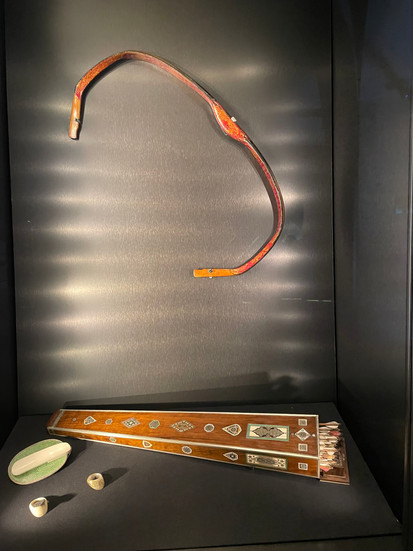




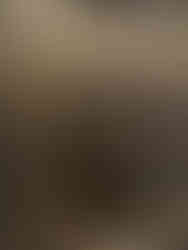






























Comments